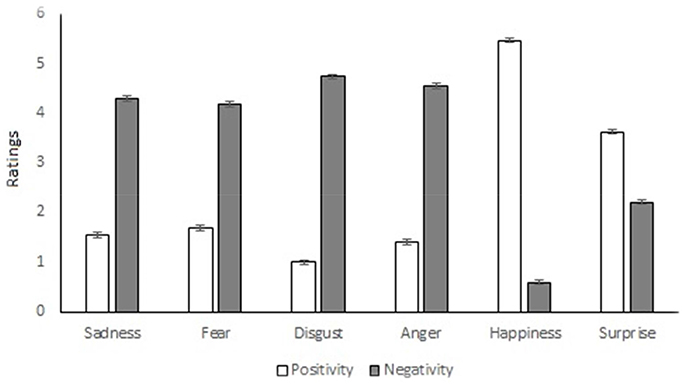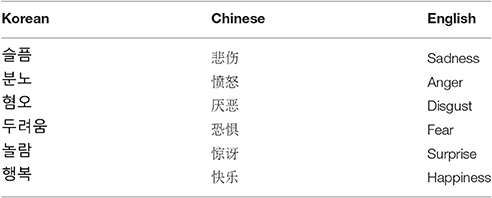Two Sides of Emotion: Exploring Positivity and Negativity in Six Basic Emotions across Cultures
- 1Department of Psychology, Ashoka University, Sonepat, India
- 2Department of Psychology, Queen's University, Kingston, ON, Canada
- 3School of Psychological and Cognitive Sciences, Peking University, Beijing, China
- 4Department of Psychology, New Mexico State University, Las Cruces, NM, United States
A corrigendum on
Two Sides of Emotion: Exploring Positivity and Negativity in Six Basic Emotions across Cultures
by An, S., Ji, L.-J., Marks, M., and Zhang, Z. (2017). Front. Psychol. 8:610. doi: 10.3389/fpsyg.2017.00610
In the original article, there was a mistake in the legend for Figure 1 as published. There was a transpositional error in the figure. The corrected Figure 1 appears below.
In the original article, there was a mistake in Table 1 as published. The Chinese font for “fear” was smaller than the rest of the font. The corrected Table 1 appears below. The authors apologize for these errors and state that this does not change the scientific conclusions of the article in any way.
Conflict of Interest Statement
The authors declare that the research was conducted in the absence of any commercial or financial relationships that could be construed as a potential conflict of interest.
The reviewer AK and handling Editor declared their shared affiliation.
Keywords: emotion, affect, cognition, culture, dialectical thinking
Citation: An S, Ji L-J, Marks M and Zhang Z (2017) Corrigendum: Two Sides of Emotion: Exploring Positivity and Negativity in Six Basic Emotions across Cultures. Front. Psychol. 8:1467. doi: 10.3389/fpsyg.2017.01467
Received: 17 May 2017; Accepted: 15 August 2017;
Published: 04 September 2017.
Edited by:
Luca Francesco Ticini, University of Manchester, United KingdomReviewed by:
Alex Kafkas, University of Manchester, United KingdomCopyright © 2017 An, Ji, Marks and Zhang. This is an open-access article distributed under the terms of the Creative Commons Attribution License (CC BY). The use, distribution or reproduction in other forums is permitted, provided the original author(s) or licensor are credited and that the original publication in this journal is cited, in accordance with accepted academic practice. No use, distribution or reproduction is permitted which does not comply with these terms.
*Correspondence: Sieun An, sieun.an@ashoka.edu.in
 Sieun An
Sieun An Li-Jun Ji
Li-Jun Ji Michael Marks
Michael Marks Zhiyong Zhang3
Zhiyong Zhang3
